Oil Spill Cleanup Methods for Buzzards Bay
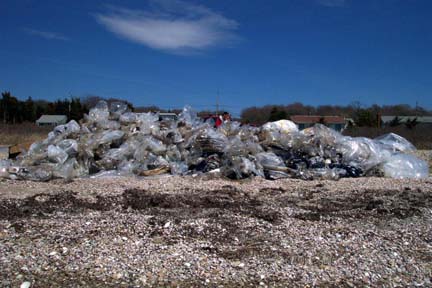
Shoreline Cleanup Methods List
Approved for use for the Bouchard No. 120 Buzzards Bay No. 6 oil spill. May be subject to change.
1A. Heavily Utilized, Public Recreational Sand Beaches
A – Manual removal with minimal clean sediment removal
B – Mechanical removal with in-kind sediment replacement
O – Vacuum removal with minimum clean sediment removal
P – Natural Attenuation
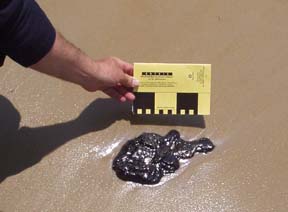
A large sticky tarball washed ashore. Smaller tarballs are more common.
1B. Less utilized, Semi-Public and Private Sand Beaches
A – Manual removal with minimal clean sediment removal
B – Mechanical removal with in-kind sediment replacement
O – Vacuum removal with minimum clean sediment removal
P – Natural Attenuation
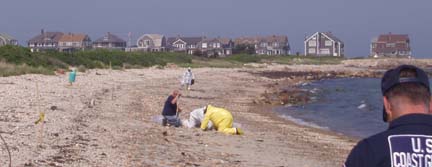
Handpicking tarballs near Mishaum Pt.
1C. Mixed Sand and Gravel, Gravel (pebble to boulder) and Rip Rap Groins (jetties)
Mixed Sand and Gravel
A – Manual removal with minimal clean sediment removal
B – Mechanical removal with in-kind sediment replacement
C – Snare (staked in intertidal zone)
D – Warm water deluge into collection
O – Vacuum removal with minimum clean sediment removal
P – Natural Attenuation
Gravel/Cobble (pebble to boulder)
E – Manual wiping
F – Manual wiping with subtidal relocation
G – Manual wiping with cleaning agent
H – High pressure/hot water wash with containment
I – On-site high pressure/hot water wash of piled rocks with containment
J – Off-site high pressure/hot water wash of piled rocks
K – Warm water deluge into collection
O – Vacuum removal with minimum clean sediment removal
P – Natural Attenuation
Rip Rap Groins (jetties)
L – Snare in/around groins
H – High pressure/hot water wash with containment
P – Natural Attenuation
1D. Rip Rap Seawalls, Bulkhead, Piers, Docks and Pilings
L – Snare in/around groins
H – High pressure/hot water wash with containment
P – Natural Attenuation
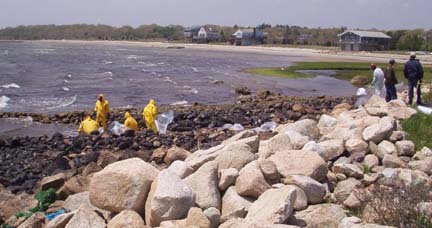
Polishing rocks with snare boom
1E. Rocky Shorelines (bedrock outcrops)
C – Snare (staked in intertidal zone)
H – High pressure/hot water wash with containment
P – Natural Attenuation
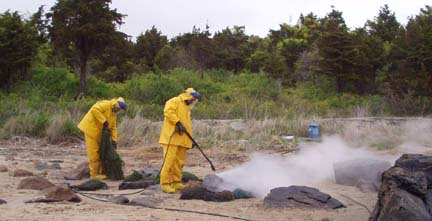
A Hotsys in use. Note the snare boom at the base of rock. A second line of boom (not shown) is parallel to shore to capture any loose oil on the incoming tide.
1F. Salt Marshes
A – Manual removal with minimal clean sediment removal
M – Removal of floatable oil
N – Manual removal of oiled wrack
P – Natural Attenuation
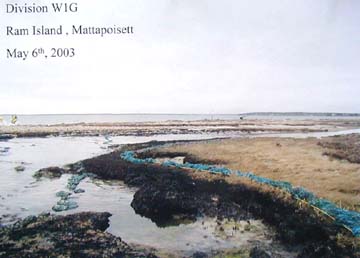
Fringing salt marsh at Ram Island. Snare boom positioned to prevention of expansion of oil into marsh.
2. Roseate Tern Habitat
site-specific plans
3. Piping Plover Habitat
site-specific plans
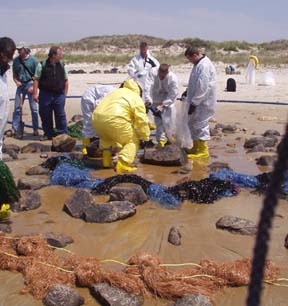
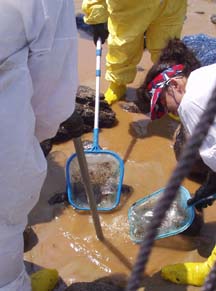
A new beach “fluidization technique” was tested and proved effective in quickly isolating buried oil. Cold seawater is jetted into the surface sediments at the depth of the oil. Globs of oil rise to the surface and are captured in nets or adsorbed to snare boom.
Click here for the June 20, 2003 Shoreline Cleanup Plan (128 kb pdf file).